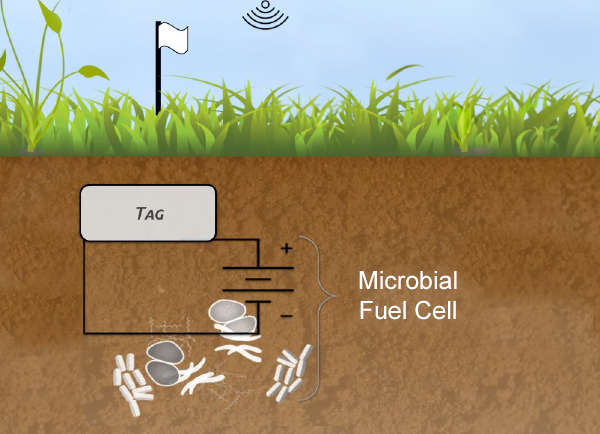Non-traditional energy sources: research and creative thinking
14 February 2024 – Vol 2, Issue 2.
EDITOR’S NOTE: Colleen’s study into soil batteries represents not just a scientific advancement but also adaptability and creativity in research. What started as a conversation and a balcony experiment during the global pandemic evolved into a significant academic pursuit. Her soil battery research embodies the essence of scientific exploration – a willingness to venture into the unknown and engage with the unexplored. The research focuses on technology and agriculture, and also underscores the importance of seizing unexpected opportunities even in the face of challenges, and becoming a creative thinker.
Imagine a world where we power our electronics not with conventional batteries or electricity grids, but with soil – one of the most abundant and overlooked resources on our planet. Soil batteries, or microbial fuel cells (MFCs), harnesses the power of tiny microorganisms found in soil and wetlands to generate electricity.
These ‘dirt batteries’ leverage the behaviour of naturally occurring bacteria that feed on organic matter in the soil, and produce electrons as a by-product of their normal respiration activities. The energy harvested is minuscule – on the order of microwatts – so it cannot power energy-hungry devices. But, electronics have progressed enough such that nowadays, microwatts are actually enough power for some workloads, such as underground tags that we use to measure soil moisture.
My PhD was in the electrical engineering department at Stanford University. Despite Stanford being nicknamed “The Farm”, there was not much research on the intersection of technology and agriculture. I was one of the only people doing work in this area. In short, my work was a bit “underground” – so much so that one time I was sitting in a common area, and a younger student leaned over and asked what I was working on. “Dirt,” I replied cheerfully. The younger student paused and looked confused. He then asked me if D.I.R.T. was an acronym for something, like a new machine learning pipeline he hadn’t heard of yet. Nope! I was working with real, live dirt.

Microbial fuel cell (MFC) attached to a low-power wireless soil moisture measurement tag. Image © Colleen Josephson.
I ended up working in this field as a result of two factors: frustration, and passion.
Like many others, I went through a mid-PhD crisis in my second year, where I was finding it difficult to motivate myself to put in the effort to revise a paper rejection. Frustrated, I was wondering if anyone cared about my current area of work, and if it would ever have any impact. From this frustration, I decided that a change of pace might be a good idea. One of my lab colleagues introduced me to Ranveer Chandra, of Microsoft Research, who was recruiting interns for a project related to farming. He was interested in the idea of using low-power wireless signals as an efficient way to measure soil moisture.
I grew up in a small town in New England, USA. When I moved to California in 2014, one of the things that excited me the most was my newfound ability to grow citrus, and I started growing a salsa garden. The opportunity to work with Ranveer and merge two things that I am passionate about – growing food and wireless communication – intrigued me.
I decided to pursue the internship with Microsoft Research, and through this experience, my interest in sustainable agriculture technologies blossomed, eventually leading to my work on dirt batteries.
Why soil? Why not focus on air, for example, or water?
Like many of the best parts of life, my work with soil batteries is a bit of a happy accident. The most fun part of being a researcher is talking to other researchers about interesting things. I was chatting with a fellow grad student about my soil moisture sensing work when he asked if I had ever heard of dirt batteries. I had not. We mused that harvesting energy from soil would be a pretty nifty way to power my soil moisture sensors. I bookmarked a paper he sent me, and shortly thereafter it was nearly forgotten.
However, a few months later the COVID-19 pandemic hit, and it became clear that my summer research would not go as planned. We had approximately two days of notice to gather necessary equipment from the lab to work from home during (what turned out to be) an extended lockdown. While wracking my brain for what I could possibly work on from my tiny studio apartment in San Francisco, I remembered the dirt battery. I gathered the equipment to do some small experiments on our balcony, and we got fascinating results. It’s not so much that I consciously chose to work on soil, but more that we had so many questions about what we were observing, and it turned out that there was rather little research published in this area. The only way to find out was to investigate it ourselves. I ended up spending my entire summer on this work, eventually dedicating a chapter to it in my thesis, and then a few years later I became faculty and received grant funding to continue my investigations.
Informing land-management decisions with data from sensors is shown to improve outcomes. For example, using soil moisture sensors typically leads to irrigated crops consuming 10-50% less water while maintaining yields. However, sensors are under-utilized largely because we don’t have the same power and communication infrastructure available outdoors as we do indoors. I see soil batteries as one part of a multi-faceted approach to supplying power to outdoor sensor networks. Sometimes solar works, other times, soil power might be better (for example, if you want to deploy electronics completely underground).
We’re still actively investigating how environmental factors, like soil properties, temperature, and microbial communities, affect the performance of soil-based MFCs. From what we and others have observed so far, the microbial power output seems to be especially sensitive to temperature – the warmer the soil is, the more electricity is produced (within reason). I like comparing this to another favourite microbial activity – sourdough starter proofing. Just like bread proves faster in warm, humid conditions, the soil microbes are also more active in those same conditions. That said, predicting how the microbes will behave in certain conditions is very much still an active area of research, in no small part because biological systems are very complicated and challenging to model. These challenges are exacerbated further when you look at microbial communities in the ‘real world’, such as those deployed in the field (vs laboratory experiments).
© Journal of Creativity and Inspiration.
Image copyright as specified.
Dr. Colleen Josephson is an Assistant Professor in the ECE department at UC Santa Cruz. Her research interests include wireless sensing and communications systems, with a focus on technology that furthers sustainable practices. Her work has spanned designing novel sensing paradigms for agriculture, inventing techniques for ultra-low power communication in indoor sensor networks, and exploiting non-traditional energy sources.
